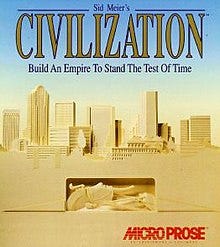Just One Turn More.
That’s the thought that ran through my mind as I had to turn off the computer and actually study during college. I’d moved my units, picked my research, made my decisions and now the computer was going to the next year, as my Civilization advanced.
Games are always a threat to a certain class of college student. I gave an early Christmas present of Lemmings the night before a room-mate’s final, and another friend failed a class due to a night-long game of Titan just before the final. But Sid Meier’s Civilization swept through campus like an East German teacher’s red pen, knocking points off GPAs for almost every gamer.
Civilization had combat — Phalanxes and Charioteers eventually turning into Rifleman and Mechanized Infantry, all the way up to Nukes. And it had a technology tree. But it also had “happiness.” Unlike the “godlike view” of many games where you could just set up your economy and go, your people had say in the matter. Civilizations do not live on bread alone, you needed some circuses. A decade before “Meeple” — short for ‘my people’ — was coined, Civilization made you feel for them.
Sure, you won by conquering the other Civilizations and taking over the world — maybe by a rush of units, or getting better technologies or building wonders of the world — but you didn’t just have to consider your enemies. Your subjects also mattered. Too little food? Slow growth! Unhappiness? Revolution!
Civilization wasn’t the first game to really use the Personal Computer’s ability to shove a complex system under the hood, or to simulate reasonable opponents; but it was one of the earliest to reach a wide audience and break out. But that model didn’t come out of thin air.
If Sid Meier had seen the future of games, it was because he was standing on the shoulders of … Francis Tresham.
Civilization (the board game this time) had shown up a decade earlier, and pretty much everything (and more) that the video game uses first appeared in Tresham’s design.
Meier — to his credit — is clear that the board game inspired the video game1. In fact, Meier also credited Tresham’s 1830 with inspiring Railroad Tycoon2. I am not enough of a game historian to know if there was ever another pairing of great board games inspiring great videogames, but I can’t think of another3.
The boardgame — not having any CPU power — is a much sparser affair but in order to win you have to build cities, feed your people (to grow the population).
Tresham’s game is widely credited with creating the technology tree, although popularizing it would be more accurate4. Combat is practically non-existent, with much of the focus on trading between players, with a system reminiscent of Pit!, with value growing as you get more and more of one type of good; but players do not have to be completely truthful during trades and calamity cards can be passed around. The value from the trades are used to buy the technologies, which are not only help the player during the game but are also required to move up the victory track (at certain points).
Tresham’s Civilization is considered one of the earliest “Grand Strategy” games (focused on much more than combat) as well as an early “4X5” game, although the final X (“Exterminate”) is not necessary to win, or even particularly helpful (although a well timed strike can be important, and the threat of conflict looms large). One ‘selling point’ of the board game is that handles 7 players well.
Both games are incredibly well suited to there respective mediums. Tresham’s Civ focuses on deal-making (both in trading and the ever present of “Which player is winning and what shall we do about it?”) that is best handled face-to-face and over the board. Meier’s Civ — while still having some simpler trading and diplomacy — is a much more militant game with many more moving parts and book-keeping, but all of that is handled by the computer.
And both are going strong. My personal steam deck has Civilization VI from years ago, and Civilization VII just released last month. The board game still has several relatives in print6 although many people prefer the cleaner, simpler design of the original. And of course both games serve as inspiration (direct or indirect) to game designers and includes board games trying to capture the feel of the video game7 .
You could debate if which game deserves an entry into the Most Influential Games of the 20th Century. That’s what this site is about, after all. Do you go for the much more well known computer game, or Tresham’s precursor board game that served as Meier’s muse?
Personally? I feel both are deserving.
As I researched this article this became less clear, with some sources claiming that Meier said he’d never played the game. But the computer game was also designed by Bruce Shelley who’d been at Avalon Hill and states that Meier owned a copy. Microprose did make sure to license the name before publishing, so it might be more fair to say “Meier admits that the board game inspired the videogame”
As mentioned in my article on 1830.
And — according to Wikipedia — both of Meier’s games were published barely a year apart!
I am informed that Stellar Conquest got there earlier, and others probably exist.
“Explore, Expand, Exploit and Exterminate”
Such as Mega Civilization, which is inspired by Civilization but built to allow up to 18 (!) players, although BGG and personal stories I’ve heard indicates its somewhat of a dancing bear at that number.
In my opinion Through the Ages does it very well, although I have not tried the amusing-and-confusing Sid Meier’s Civilization: The Board Game




